“The Birds”
The Habur ware ceramic assemblage of early second millennium BC northern Mesopotamia was identified by Max Mallowan (1937) at Chagar Bazar, and treated systematically by Carol Kramer in her Dinkha Tepe analysis (Hamlin 1971, 1974). Shortly thereafter, excavations at Tell Leilan provided a mass of new Habur ware assemblages from the public buildings of Shamshi Adad’s capital city: the spiral-column adorned Acropolis Northeast temples, the archive-rich Lower Town East palaces, and the foreign embassy at the Lower Town North Palace. Even the earliest Leilan excavations in 1979 retrieved some Habur ware surprises, including the rare “birds” sherds, that had previously been considered diagnostic of the succeeding Nuzi ware assemblages. Hence the earliest publications of the Acropolis Northeast temples included an illustration of the “birds” sherds (Weiss 1985).
In subsequent studies these Leilan ceramic assemblages were typologically quantified (Frane 1996; Pulhan 2000), a relatively unusual procedure among Habur ware studies (McMahon 2009; Schmidt 2013) that had only identified “presence-absence” within unquantified ceramic assemblages, as at Tell al-Rimah (Postgate, Oates and Oates 1997) and Tell Brak (Oates, Oates, and McDonald 2001). However, unquantified “presence-absence” ceramic assemblage data, oftentimes only including whole vessels, preclude spatial distribution analyses and have always presented chronological weaknesses (Doran and Hodson 1975; Bortolini 2017). A famous example is the whole vessel presence-absence treatment of the Eridu ceramic sequence (Oates 1960) that proved difficult to use in dating Ubaid period ceramics of the Warka survey (Adams and Nissen 1972). The shape typology recording of the Eridu analysis is also illustrative.
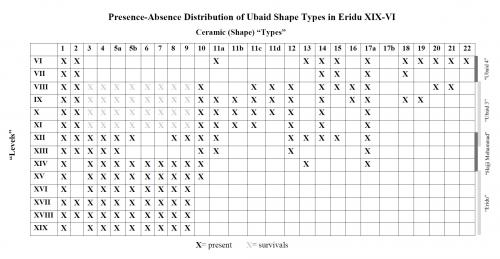
The Habur ware assemblages at Tell Leilan included the following quantities of coded diagnostic sherds (partially reduced for final stratigraphic provenience analysis):
Acropolis Northeast Building Level II: 3,321
Acropolis Northeast Building Level III: 769
Lower Town Palace East: 2,187
Operation 4A: 251
Lower Town Palace North: 1,621
Total: 8,149 coded diagnostic sherds
The Leilan ceramic assemblages are dated by the regnal years of Shamshi-Adad and his successors that are documented in floor-retrieved assemblages of cuneiform tablets and inscribed seal impressions (Weiss 1985; Whiting 1990; Vincente 1991; Ismail 1991; van de Mieroop 1994; Ristvet and Weiss 2011). These regnal years are, in turn, now securely assignable to calendar years through the tree-ring calibration of radiocarbon dates (Manning et al 2016).
Oguchi (2006) has suggested, however, that the floor-retrieved cuneiform tablets and inscribed seal impressions at Tell Leilan do not date the ceramic assemblages on the floors. He argues, for example, that the jar-stored beer-archive that was scattered on the room 12 floor of the Lower Town North palace (van de Mieroop 1994) was laying on the floor for several decades until a later “birds”-decorated Habur ware vessel was dropped on the adjacent room 10 floor. There is no evidence for comminution of the Lower Town North palace beer archive tablets, however. The rare Leilan Habur ware “birds” sherds that are illustrated here, from the mudbrick collapse strata of the Leilan monumental buildings, likely date to the time of their floor-provenience dated cuneiform tablets and inscribed seal impressions. Two similar “birds” sherds, among approximately 5,600 diagnostic sherds, were retrieved within possibly contemporary Chagar Bazar occupations (McMahon 2009: Pl.68).
References
Adams, Robert McC. and Hans J. Nissen. 1972. The Uruk Countryside. Chicago: University of Chicago Press.
Bortolini, Eugenio. 2017. Typology and Classification. In Alice Hunt, ed., The Oxford Handbook of Archaeological Ceramic Analysis. Oxford: Oxford University Press. DOI: 10.1093/oxfordhb/9780199681532.013.38
Doran, J.E. and F.R. Hodson. 1975. Mathematics and Computers in Archaeology. Cambridge: Harvard University Press.
Frane, Julia E. 1996. The Tell Leilan Period I Habur Ware Assemblage. Ph.D. dissertation, University of North Carolina at Chapel Hill.
Hamlin, Carol. 1971. The Habur ware ceramic assemblage of northern Mesopotamia: an analysis of its distribution. Ph.D. dissertation. University of Pennsylvania.
Hamlin, Carol. 1974. The early second millennium ceramic assemblage of Dinkha Tepe. Iran 12: 125-153.
Ismail, Faruq. 1991. Altbabylonische wirtschaftsurkunden aus Tell Leilan (Syrien). Ph.D. dissertation, Eberhard-Karls Universität Tübingen.
Mallowan, M.E.L. 1937. The Excavations at Tall Chagar Bazar and an Archaeological Survey of the Habur Region. Second Campaign, 1936. Iraq 4: 91–177.
Manning, Sturt W., Carol B. Griggs, Brita Lorentzen, Gojko Barjamovic, Christopher Bronk Ramsey, Bernd Kromer, Eva Maria Wild. 2016. Integrated Tree-Ring-Radiocarbon High-Resolution Timeframe to Resolve Earlier Second Millennium BCE Mesopotamian Chronology. PLOS One. https://doi.org/10.1371/journal.pone.0157144
McMahon, Augusta. 2009. Once there was a place. Settlement archaeology at Chagar Bazar, 1999-2002. London: British Institute for the Study of Iraq.
Oates, D., Oates, J. and McDonald, H. 2001. Excavations at Tell Brak. Vol.1: The Mitanni and Old Babylonian Periods. London: McDonald Institute for Archaeological Research.
Oates, Joan. 1960. Ur and Eridu, The Prehistory. Iraq 22: 32-50. https://doi.org/10.2307/4199667
Oguchi, Hiromichi. 2006. The date of the beginning of Khabur Ware Period 3: evidence from the Palace of Qarni-Lim at Tell Leilan. al-Rāfidān 27: 45-58.
Postgate, Carolyn, David Oates, and Joan Oates. 1997. The Excavations at Tell al Rimah: The Pottery. Iraq Archaeological Reports 4, British School of Archaeology in Iraq, London/Aris and Phillips Ltd., Warminster.
Pulhan, Gül. 2000. On the Eve of the Dark Age: Qarni-Lim’s Palace at Tell Leilan. Ph.D. dissertation. Yale University.
Ristvet, Lauren and Harvey Weiss. 2011. Micro- and Macro-Contexts of the Tell Leilan Eastern Lower Town Palace Archives., In J. Eidem, The Royal Archives from Tell Leilan. Old Babylonian Letters and Treaties from the Lower Town Palace East. Leiden: PIHANS 117.
Schmidt, Conrad. 2013. Ausgrabungen 1998-2001 in der Zentralen Oberstadt von Tall Mozan/ Urkeš. Die Keramik der Früh-Ǧazīra V- Alt- Ǧazīra II-Zeit. Studien zur Urbanisierung Nordmesopotamiens (SUN), Serie A, Bd. 4. Wiesbaden: Harrrassowitz.
van de Mieroop, Marc. 1994. The Tell Leilan Tablets 1991: A Preliminary Report. Orientalia 63: 305-344.
Vincente, Claudine A. 1991. The 1987 Tell Leilan tablets dated by the limmu of Habil-kinu. Ph.D. dissertation, Yale University.
Weiss, Harvey. 1985. Tell Leilan on the Habur Plains of Syria. Biblical Archaeologist 48: 6–34.
Whiting, R.M. 1990. The Leilan Tablets: A Preliminary Report, in H. Weiss, P. Akkermans, G. J. Stein, D. Parayre and R. M. Whiting. 1985 Excavations at Tell Leilan, Syria. American Journal of Archaeology 94: 568–579.
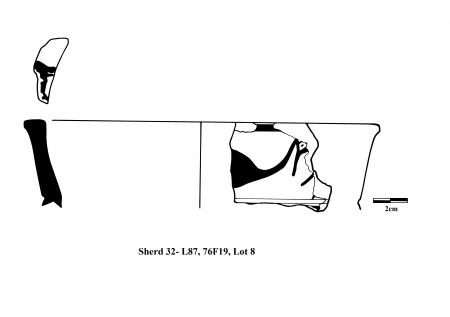
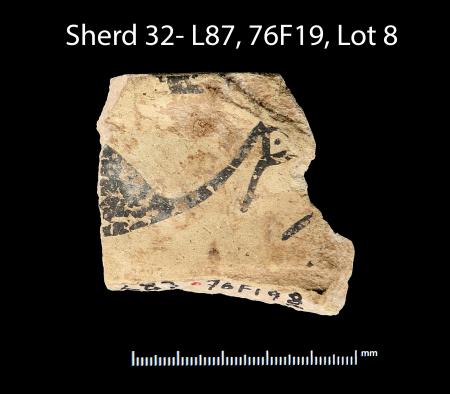
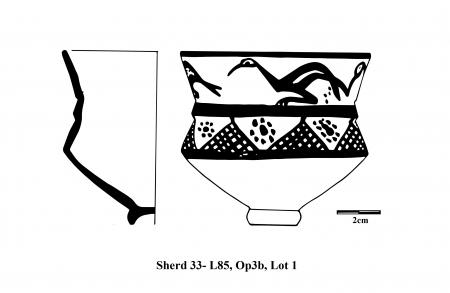
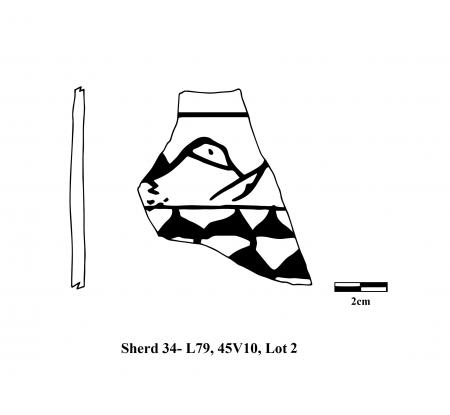

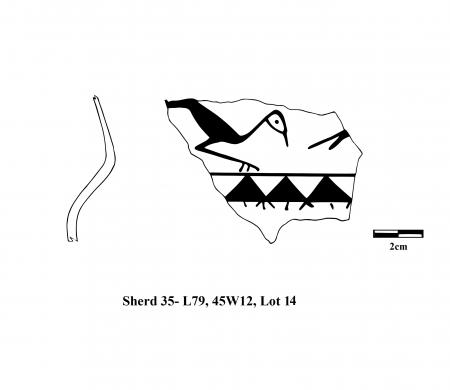
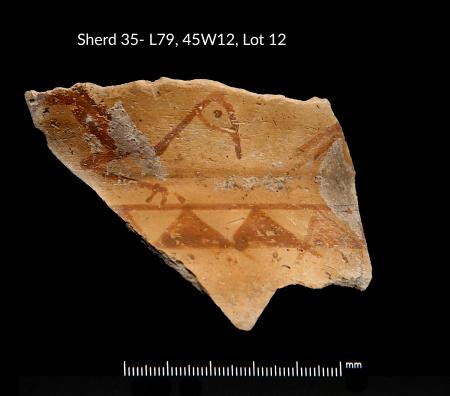
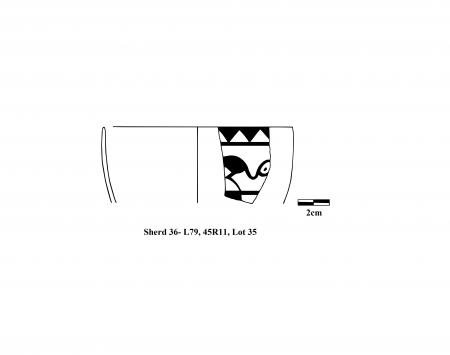
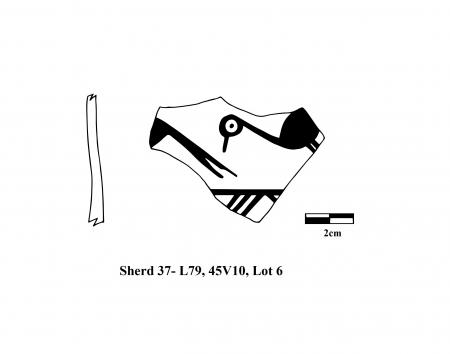
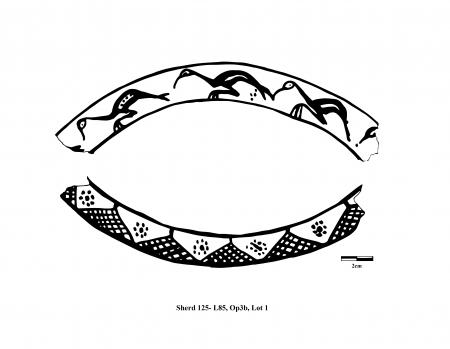
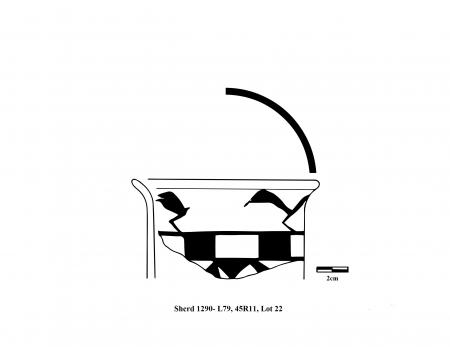
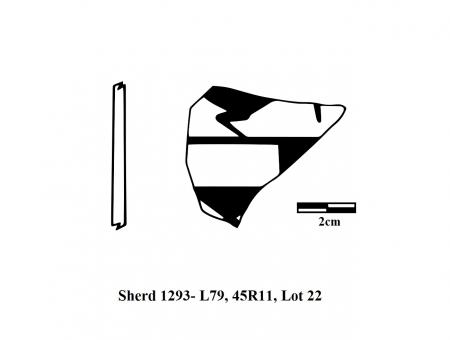
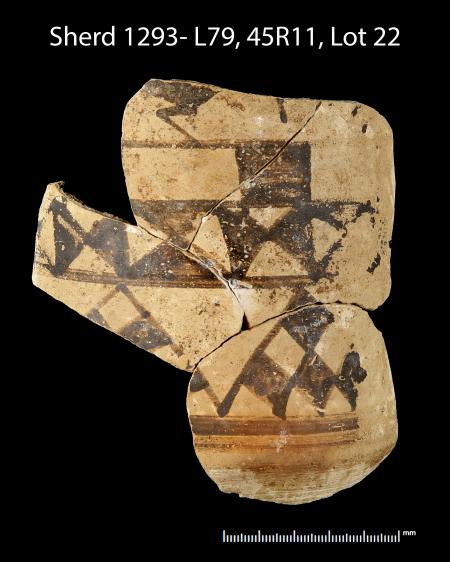
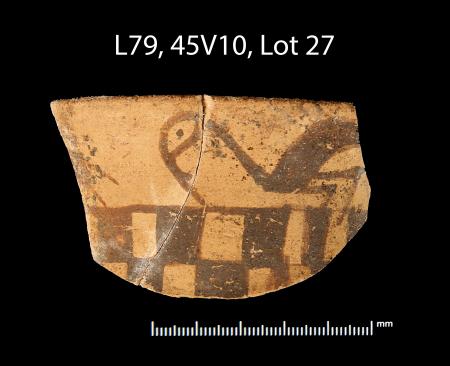
Contexts of Bird Sherds, by sherd number above:
32.L87_76F19_Lot8_Sherd, D=18cm
Medium chaff tempered buff ware with smoothed surface. Part of painted bird design. Unstratified, post third-millennium.
33.L85_Op3b_Lot1_Sherd, D=8.8cm
Object Number: L85-173. Light yellow to very bright brownish-pink buff fine ware. Black painted bird design with cross hatched triangles. Unstratified topsoil.
34.L79_45V10_Lot2_Sherd
Fine tempered buff ware with cream slip and black painted design. Body sherd with fragment of painted bird design with triangles. Brick collapse in test trench along the north baulk with light, fine soil. Lot was brick collapse in the north test trench.
35.L79_45W12_Lot14_Sherd
Straw tempered buff ware with red painted design. Parts of two birds standing on horizontal band with three solid triangles with feet. Excavated from black, ashy pit filled with occupation debris.
36.L79_45R11_Lot35_Sherd, D=12cm
Fine tempered buff ware with red painted design. Partial painted bird design with triangles and painted bands. In east half of the square, south of the south façade of the BLII temple and is contemporary with the BL II Temple.
37.L79_45V10_Lot6_Sherd
Straw tempered buff ware with painted design. Parts of two birds and oblique stripes. Excavated from pit filled with ash and bones.
125.L85_Op3b_Lot1_Sherd
Object Number: L85-173. Small ring-based bowl or cup. Mostly complete.
Painted rim design with birds and cross hatched triangles. Lot included bricks of the Level I building and topsoil in Op3b.
1290.L79_45R11_Lot22_Sherd, D=12.5
Fine tempered buff ware with cream slip. Painted black design with parts of birds. Lot 22 is a mixed lot in the southwest corner of the square, south of the BLII temple façade and contemporary with that temple.
1293.L79_45R11_Lot22_Sherd
Fine tempered buff body sherd with cream slip. Black painted design with part of a bird, similar to sherd 1290. Lot 22 is a mixed lot in the southwest corner of the square, south of the BLII temple façade and contemporary with that temple.

